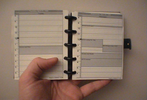



This paper explores architectural support for interfaces combining pen, paper, and PC. We show how the event-based approach common to GUIs can apply to augmented paper, and describe additions to address paper's distinguishing characteristics. To understand the developer experience of this architecture, we deployed the toolkit to 17 student teams for six weeks. Analysis of the developers' code provided insight into the appropriateness of events for paper UIs. The usage patterns we distilled informed a second iteration of the toolkit, which introduces techniques for integrating interactive and batched input handling, coordinating interactions across devices, and debugging paper applications. The study also revealed that programmers created gesture handlers by composing simple ink measurements. This desire for informal interactions inspired us to include abstractions for recognition. This work has implications beyond paper - designers of graphical tools can examine API usage to inform iterative toolkit development.







Students, scientists and engineers have to choose between the flexible, free-form input of pencil and paper and the computational power of Computer Algebra Systems (CAS) when solving mathematical problems. Hands-On Math is a multi-touch and pen-based system which attempts to unify these approaches by providing virtual paper that is enhanced to recognize mathematical notations as a means of providing in situ access to CAS functionality. Pages can be created and organized on a large pannable desktop, and mathematical expressions can be computed, graphed and manipulated using a set of uni- and bi-manual interactions which facilitate rapid exploration by eliminating tedious and error prone transcription tasks. Analysis of a qualitative pilot evaluation indicates the potential of our approach and highlights usability issues with the novel techniques used.




This paper presents Foldable User Interfaces (FUI), a combination of a 3D GUI with windows imbued with the physics of paper, and Foldable Input Devices (FIDs). FIDs are sheets of paper that allow realistic transformations of graphical sheets in the FUI. Foldable input devices are made out of construction paper augmented with IR reflectors, and tracked by computer vision. Window sheets can be picked up and flexed with simple movements and deformations of the FID. FIDs allow a diverse lexicon of one-handed and two-handed interaction techniques, including folding, bending, flipping and stacking. We show how these can be used to ease the creation of simple 3D models, but also for tasks such as page navigation.